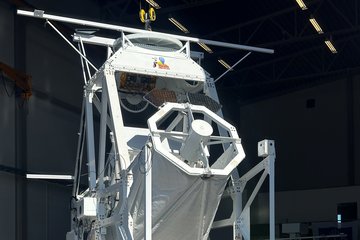All genres
101.
Journal Article
The first operation and results of the Chung-Li VHF radar. Handbook for MAP 20, pp. 359 - 363 (1986)
102.
Journal Article
Observations of mesoscale vertical velocities around frontal zones. Handbook for MAP 20, pp. 35 - 43 (1986)
103.
Journal Article
UHF and VHF radar observations of thunderstorms. Handbook for MAP 20, pp. 288 - 292 (1986)
104.
Journal Article
Method to determine the optimal parameters of the Arecibo 46.8 MHz antenna system. Handbook for MAP 20, pp. 420 - 424 (1986)
105.
Journal Article
A comparison of thunderstorm reflectivities measured at VHF and UHF. Handbook for MAP 20, pp. 279 - 287 (1986)
106.
Journal Article
Comparison of vertical velocities analyzed by a numerical model and measured by a VHF wind profiler. Handbook for MAP 20, pp. 44 - 47 (1986)
107.
Journal Article
Observations of vertical velocity power spectra with the SOUSY VHF radar. Handbook for MAP 20, pp. 231 - 235 (1986)
108.
Journal Article
A cooperative synchronous observation of winds and tides in the equatorial lower stratosphere and mesosphere using VHF radars at Jicamarca and Arecibo. J. Geomag. Geoelectr. 38, pp. 81 - 97 (1986)
109.
Journal Article
Simultaneous VHF and UHF radar observation of the mesosphere at Arecibo during a solar flare: a check on the gradient-mixing hypothesis. Handbook for MAP 20, pp. 103 - 110 (1986)
110.
Journal Article
The influence of velocity variability on the determination of wind profiles. Handbook for MAP 20, pp. 60 - 64 (1986)
111.
Journal Article
Half-day and four-day waves in the stratosphere. Handbook for MAP 20, pp. 97 - 98 (1986)
112.
Journal Article
Determination of the Brunt-Väisälä frequency from vertical velocity spectra. Handbook for MAP 20, pp. 168 - 172 (1986)
113.
Journal Article
The use of the experimentally deduced Brunt-Väisälä frequency and turbulent velocity fluctuations to estimate the eddy diffusion coefficient. Handbook for MAP 20, pp. 173 - 178 (1986)
114.
Journal Article
The relation of gravity waves and turbulence in the mesosphere. Handbook for MAP 20, pp. 179 - 183 (1986)
115.
Journal Article
On the varying slope of velocity spectra. Handbook for MAP 20, pp. 225 - 227 (1986)
116.
Journal Article
Comparison of reflectivity and wind profiles measured on 46.8 MHz and 430 MHz at the Arecibo Observatory. Handbook for MAP 20, pp. 307 - 308 (1986)
117.
Journal Article
MST radar networks and campaign session summary and recommendations. Handbook for MAP 20, p. 309 (1986)
118.
Journal Article
The application of matched-filter analysis to deduce a best estimate of mean Doppler velocity. Handbook for MAP 20, pp. 469 - 471 (1986)
119.
Journal Article
On the use of colour reflectivity plots to monitor the structure of the troposphere and stratosphere. Handbook for MAP 20, pp. 489 - 490 (1986)
120.
Journal Article
Investigations of the lower and middle atmosphere at the Arecibo Observatory and a description of the new VHF radar project. Handbook for MAP 20, pp. 349 - 358 (1986)











